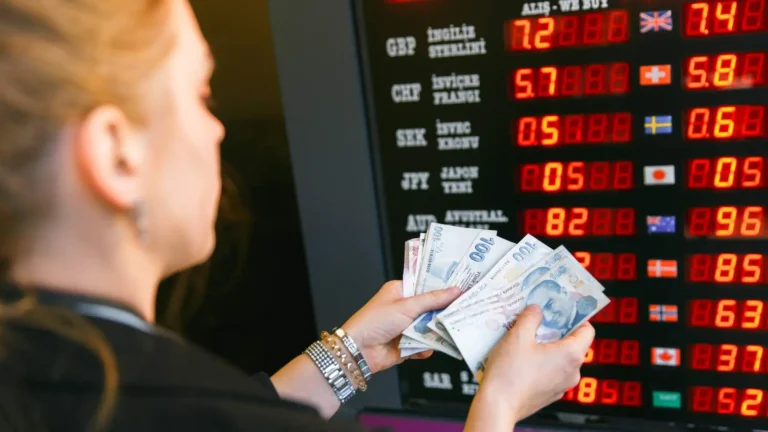Table of Contents
Travelers love discovering new cultures, but nobody loves getting ripped off on exchange rates and fees. Whether you’re paying for dinner in Paris, souvenirs in Tokyo, or a taxi in Mexico City, the cost of exchanging currency can quietly eat into your travel budget. In fact, according to the World Bank, travelers collectively lose billions of dollars every year to hidden foreign exchange fees.
The good news? With smart planning, you can keep more of your money. From fee-free cards to local hacks, here’s a complete guide to best ways to exchange currency for cheap in 2025.
Why Currency Exchange Costs Add Up
Every time you convert dollars into another currency, two things happen:
- Exchange rate markup: Banks and exchange counters rarely give you the “mid-market” rate (the real rate you see on Google). Instead, they add 2–5% on top.
- Transaction fees: ATMs, credit cards, or counters often tack on flat fees ($3–$10) per withdrawal or transaction.
On a two-week trip where you spend $2,000, those small percentages can cost you $100–$200 — money better spent on meals, tours, or experiences. Here’s more on Emergency Funds Abroad: How to Access Cash Safely.
Option 1: Fee-Free Credit Cards
The simplest way to pay abroad is with a credit card that has no foreign transaction fees. Most travel cards fall into this category, and they also provide strong fraud protection.
Why it’s cheap: You get close-to-market exchange rates, no 2–3% surcharge, and often earn rewards points.
How to do it safely:
- Always choose to be charged in the local currency instead of USD. “Dynamic currency conversion” looks convenient but hides terrible rates.
- Carry two cards from different networks (Visa + Mastercard) in case one is declined.
- Use credit cards for larger purchases (hotels, restaurants), not small shops that may add card surcharges.
Option 2: Partner Bank ATMs
Withdrawing local currency from ATMs is often cheaper than using currency exchange counters, but only if you use the right machines. Many U.S. banks belong to global ATM alliances that waive foreign fees.
Examples:
- Bank of America customers can withdraw fee-free at Barclays (UK) and BNP Paribas (France).
- Chase partners with select ATMs globally through Visa/Plus networks.
- Charles Schwab Bank reimburses all foreign ATM fees worldwide.
Why it’s cheap: You avoid double-fees (your bank + foreign ATM) and often get mid-market exchange rates.
Pro tip: Withdraw larger amounts less frequently to minimize flat fees, but never so much that you risk losing big if stolen.
Option 3: Prepaid Travel Cards
Prepaid cards let you load money before you leave, sometimes locking in favorable rates. They’re particularly useful if you’re traveling to multiple countries, since many support multi-currency wallets.
Why it’s cheap: They cap your exposure to bad exchange rates and prevent overspending, since you can only use the loaded amount.
Drawbacks: Some charge reload or inactivity fees, so compare providers carefully. Discover about Travel Insurance: Do You Need It for Every Trip?
Popular in 2025: Wise, Revolut, and Travelex Money Cards.
Option 4: Digital Wallets and Apps
Apps like Wise, Revolut, and PayPal now allow you to spend abroad directly from your phone, often with real-time exchange rates and minimal markups. Wise, for example, uses the mid-market rate plus a tiny transparent fee.
Why it’s cheap: You avoid most of the hidden costs banks sneak in. Plus, you don’t carry as much cash.
Bonus: Many of these apps now include budgeting features, making it easier to track your spending abroad.
Option 5: Airport Counters (Only as a Last Resort)
Airport exchange counters are notoriously expensive, with some charging spreads of 10% or more. But in true emergencies, they serve as a fallback.
How to use safely:
- Exchange just enough for immediate needs (taxis, snacks, first night at hotel).
- Do the bulk of your withdrawals later from an ATM or via digital wallets.
Think of counters as financial first aid, not your main tool.
Read: Travel Safety on a Budget: 10 Best Digital Tools
Option 6: Peer-to-Peer Exchange Apps
A newer option in 2025: apps that allow travelers to swap currencies directly with locals or other travelers. Apps like CurrencyFair and Pangea facilitate peer-to-peer currency exchanges at close-to-market rates.
Why it’s cheap: Cutting out banks means avoiding inflated fees.
Safety tip: Only use trusted platforms with verified users, and avoid meeting strangers for physical exchanges.
Peak Destinations With the Highest Currency Exchange Costs
| Country | Typical ATM Fee | Typical Exchange Counter Markup | Best Strategy |
| Thailand | $6–$8 per withdrawal | 5–10% markup | Use fee-free ATM cards, withdraw larger amounts |
| Mexico | $3–$5 | 4–6% markup | Stick to partner bank ATMs |
| Japan | $2–$4 | 3–5% markup | ATMs at 7-Eleven & Japan Post Bank widely accept foreign cards |
| Egypt | $2–$5 | 6–10% markup | Withdraw local cash, avoid tourist counters |
| Switzerland | $3–$6 | 2–4% markup | Credit cards with no FX fees are king |
Knowing the worst offenders helps you prepare in advance and avoid the traps.
When to Exchange Before You Leave vs. On Arrival
- Before you leave: Good if your home bank offers favorable exchange rates (rare). Also smart if traveling somewhere with limited ATMs (rural Africa, remote islands).
- On arrival: Often cheaper to withdraw cash locally, since ATMs use global interbank rates. Most urban destinations favor this option.
Rule of thumb: bring $100–$200 in local cash before departure for emergencies, then use ATMs and cards for the rest.
How Much Cash Should You Carry?
Carrying too much cash abroad increases theft risk. Carry enough for daily expenses, $50–$100 equivalent, while relying on cards or apps for big purchases. Split your money: some in your wallet, some hidden in luggage, and a small emergency stash (like $50 USD) for backup.
Currency Exchange and Travel Scams
Beware of common scams:
- “Dynamic currency conversion” at shops: You’ll be asked if you want to pay in USD. Always decline — you’ll pay inflated rates.
- Fake exchange kiosks: In some countries, unlicensed counters prey on tourists. Only use banks or reputable counters.
- ATM skimmers: Stick to machines inside banks or airports, not standalone street ATMs.
A little caution goes a long way in protecting your money.
Also Read: Top 10 Travel Scams to Avoid in 2025
Timing the Market: Do Exchange Rates Fluctuate Seasonally?
Most travelers assume exchange rates are random, but currency markets follow cycles. For example, the U.S. dollar historically strengthens during times of global uncertainty, while tourist-heavy currencies like the euro often rise in the summer travel season. While it’s impossible to predict perfectly, travelers who pay attention to financial news can sometimes save extra by exchanging when the dollar is strong. Apps like XE or OANDA allow you to set alerts when your target rate improves, giving you an edge over simply exchanging at the last minute.
Airport vs. City Center: Why Location Matters
Exchanging money at the airport is almost always the most expensive option, because you’re a “captive customer.” City-center banks and ATMs generally offer better rates, sometimes 5–8% cheaper. In tourist districts, kiosks may also inflate fees, while suburban or residential bank branches are fairer. A smart habit: exchange a small amount at the airport (enough for transport and food), then do the bulk in the city at banks or ATMs with better rates.
Multi-Currency Accounts: The 2025 Solution
A rising trend in 2025 is multi-currency accounts offered by fintech platforms like Wise, Revolut, and Payoneer. These accounts let you hold multiple currencies at once, switch between them instantly, and even receive local bank details in different countries. For frequent travelers or digital nomads, this eliminates many fees entirely. Imagine landing in Tokyo with yen already in your Wise account: no airport exchange, no ATM fees, just a card swipe at mid-market rates.
Cashless Destinations: Do You Even Need Cash?
In some countries, like Sweden, South Korea, and the Netherlands, cash is rapidly disappearing. Almost every vendor accepts cards or mobile payments. In these destinations, you may not need more than a token amount of local currency. By contrast, in Morocco, Egypt, or rural Vietnam, cash is still king. Knowing your destination’s payment culture determines how much local money you actually need and prevents you from overspending on unnecessary conversions.
Government Regulation: Why Some Countries Have Higher Fees
Not all fees are greedy banks; sometimes they’re government-mandated. Thailand, for example, has a standard ATM fee of around $6–$8 for foreign cards. In Argentina, strict currency controls create a dual exchange rate: the “official” rate vs. the “blue dollar” street rate, which can differ by 50% or more. In such cases, knowing the rules (and what’s legal) becomes as important as choosing the right card. Researching in advance avoids surprises.
Safety vs. Savings: Striking the Balance
Chasing the absolute cheapest exchange can sometimes backfire. Street exchangers or unofficial kiosks may offer great rates, but also counterfeit bills, scams, or even theft risks. The safest strategy is often a hybrid: use fee-free cards for most spending, ATMs for local cash, and reserve exchanges for emergencies. Saving 2–3% is not worth the risk of losing hundreds to fraud. Cheap isn’t always safe; balance both.
How Much Are You Really Paying? Doing the Math
Travelers often focus only on the posted exchange rate, but the real cost is in the combined fees. For example:
- ATM fee: $5
- Bank foreign transaction fee: $3
- Rate markup: 3% on $200 withdrawal ($6)
Total cost = $14, or 7% of your money gone instantly.
Understanding this math helps you see why it’s critical to minimize both fixed fees (per withdrawal) and variable ones (rate markups).
Beem as the Missing Piece: Budget + Backup
Most guides stop at cards and ATMs, but Beem adds a unique safety layer. By budgeting your daily travel spending in advance, Beem helps ensure you’re not constantly scrambling for extra withdrawals (and paying more fees).
And with the Beem app’s Everdraft Instant Cash, you always have a cushion for emerg
encies, without falling into high-interest debt or unsafe exchanges. That combination (budget discipline + emergency access) fills a gap most travelers don’t even realize they have until it’s too late. Beem offers cash for emergencies without interest, credit checks, due dates, and no income restrictions. Get up to $1000 for emergencies, along with a range of tools that will help with budgeting, saving, spending wisely, and building credit.
FAQs About Best Ways to Exchange Currency for Cheap
Is it better to exchange cash before traveling or use ATMs abroad?
ATMs abroad usually give the best rates, especially if your bank refunds foreign ATM fees. Exchanging large amounts of cash before you leave typically results in worse rates.
What’s the cheapest way to pay abroad?
A fee-free credit card combined with occasional ATM withdrawals is the cheapest method. Apps like Wise or Revolut also offer excellent rates with minimal fees.
Should I carry U.S. dollars as backup?
Yes. USD is widely accepted in many countries and can be exchanged easily if your cards fail. Carry $100–$200 in small bills as an emergency reserve.
How do I avoid hidden fees?
Never use dynamic currency conversion (paying in USD instead of local currency). Choose banks with fee reimbursements, and avoid airport exchange counters whenever possible.
How can Beem help me manage currency abroad?
Beem helps track spending across currencies, budget for daily expenses, and provides Everdraft as a backup if you’re short on funds. By managing your cash flow digitally, you avoid many of the hidden costs that come with unplanned exchanges.
Exchange Currency for Cheap
Currency exchange can feel like a tax on travel: small, constant fees that drain your budget. But it doesn’t have to be that way. With fee-free cards, smart use of ATMs, digital wallets, and awareness of local practices, you can save hundreds on every trip.
In 2025, the best travelers aren’t just adventurous; they’re financially savvy. By pairing these strategies with Beem’s budgeting and Everdraft safety net, you’ll keep your money safe, stretch your budget further, and focus on what matters most: the experiences, not the fees. Consider using Beem to spend, save, plan and protect your hard-earned money like an pro with effective financial insights and suggestions.
Download the Beem app here.















































